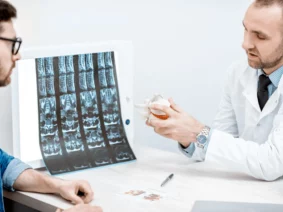What Is Microvascular Decompression?
Microvascular decompression (MVD) is a surgical procedure that involves redirecting or removing an artery or vein that is compressing one of the 12 cranial nerves, nerves that stem directly from the brain as opposed to the spinal cord. It is performed to relieve the pain and muscle twitching that can result from the various cranial nerve disorders that cause this compression.
The most common of those disorders, trigeminal neuralgia (TN), is considered one of the most painful of all human conditions. The fact that pain can be relieved through MVD surgery makes it a very-sought after and important operation in the field of neurosurgery.
MVD is considered very effective in treating trigeminal neuralgia, with a relatively low risk of the recurrence of pain. In a scientific comparison of the various surgical procedures, microvascular decompression (MVD) represented the most effective and safe surgical option for the treatment of trigeminal neuralgia.
What Does Microvascular Decompression Treat?
Microvascular decompression is used to treat a group of conditions known as neurovascular compression syndromes. These syndromes are the result of an artery or vein compressing a nerve root. These conditions include:
Trigeminal neuralgia – The trigeminal nerve is the largest of all the cranial nerves, and when it is compressed, the pain can become anything from an aching sensation to a sudden jolt, like electric. The condition mostly strikes those between ages 50 and 60 years old with a greater increase in incidence as people age.
Hemifacial spasm – Hemifacial spasm is a nervous system disorder characterized by frequent involuntary contractions (spasms) of the muscles on one side of the face, starting around the eye and progressing to the lower face. It is often caused by a blood vessel in contact with the facial nerve, an injury or a tumor. However, sometimes the cause is unclear or cannot be determined. This disorder can occur in anyone, although it is common among people of Asian descent, and more frequently affects women of middle-age to the elderly.
Glossopharyngeal ( or vagoglossopharyngeal) neuralgia (GPN)- This condition is generally caused by compression of a small blood vessel on the nerves that exit the lower portion of the brainstem. Its symptoms are a brief (seconds to a few minutes) but sharp pain in the tongue, throat, tonsils and ear. It occurs most commonly in those over age 40.
Candidates for Microvascular Decompression
You may be a candidate for MVD if you have certain characteristics of your condition (such as those outlined below) and are a good candidate for surgery in general.
- Patients most likely to benefit from MVD have a classic form of trigeminal neuralgia. This is characterized by the intense, jolting pain, brought about by triggers such as touching the face (putting on make-up or shaving), eating or talking. Medication usually improves the pain initially.
- While medication can be useful to treat trigeminal neuralgia or other similar disorders, this medication eventually stops working in many people with the condition. For patients in whom this therapy has failed, MVD is a possible and effective option.
- MVD is also an option for those who have had adverse effects to the medications or for whom previous surgical procedures have not been successful in rectifying the problem.
- Candidates are also those healthy enough to undergo surgery. MVD requires the use of general anesthesia. In addition, because it is also brain surgery, those with other medical conditions or who are in generally poor health may not be candidates.
- Although healthy older patients can well tolerate surgery, MVD is usually recommended to those under age 70 who are at lower risk of complications from general anesthesia.
There are also other factors which come into play in the decision to recommend MVD. There are also alternative surgical procedures which may be indicated. The viability of surgery, and which type, is judged for each patient individually by a well-qualified surgeon.
How Is Microvascular Decompression Performed?
MVD surgery is performed in several stages. First, the patient is put to sleep with general anesthesia. While lying on their side, the head is put into a position which keeps it still. A small area behind the ear is prepped for a skin incision.
A craniectomy is then performed. This entails a three-inch incision to access the occipital bone. A one-inch opening is made in that bone with a drill. The bone is removed, after which the brain covering (dura) is opened to provide access to the brain to view the problematic structure, usually the trigeminal nerve.
An operating microscope is then used to visualize blood vessels that come in contact with the nerve. These vessels are either removed (veins) or disected away (arteries) from the nerve. With the latter, a tiny sponge-like material is inserted between the nerve and artery to prevent the blood vessel from returning to its normal position.
Once the sponge-like material is put in place, the dura is closed, and the very small bone opening is covered. The area is closed, and a soft adhesive dressing is used to cover the incision.
What Is Recovery Like for Microvascular Decompression?
With a craniotomy or craniectomy, post-operative headaches are possible. The surgeon will advise on the appropriate pain medication. Pain can be managed with prescription narcotic medications that are used for a limited time, after which, pain can be relieved with nonsteroidal anti-inflammatory drugs (NSAIDs) such as ibuprofen. A high percentage of patients experience rapid relief from this pain.
Following the surgery, most patients are discharged after two to three nights. There may be some pain and stiffness following the operation, but that usually subsides within a week. Normal activities can be resumed at the patient’s own pace, but a return to normal activities usually takes four to six weeks.
As with all surgery, there are some inherent risks. In MVD, there are side-effects which can be incurred with any surgery dealing with nerves. Your doctor will discuss with you any possible risks or complications of MVD and surgery in general.
MVD results have been widely studied, particularly for trigeminal neuralgia (TN). A review of studies of MVD used for TN between 2000 and 2013, with the benchmark being that success is defined as being completely pain-free, the researchers found the success rate to be 83.5 percent. Another study concluded that MVD for TN is “surely a safe and effective treatment method.”
If you are experiencing symptoms of neurovascular compression syndromes, such as trigeminal neuralgia (TN), request an appointment at Neurosurgical Associates of Central New Jersey. We can diagnose your condition and explore surgical treatments such as



